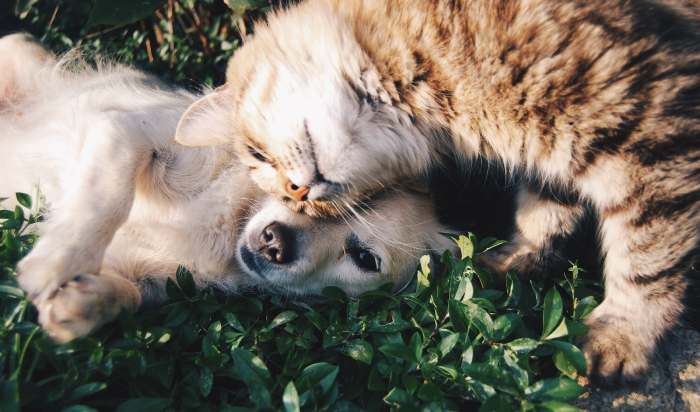Just as the siren’s song tempted sailors of lore, catnip lures cats with its irresistible allure. But you’re navigating uncharted waters when it comes to your canine companion. You’ve heard whispers of catnip’s effects on dogs, but what’s a myth and fact?
Let’s delve into the science to uncover whether this feline favorite is friend or foe for your pooch, exploring the potential risks and laying out safe usage guidelines for your furry friend’s well-being.
Understanding Catnip’s Effects: How Catnip Affects Felines and Canines Differently

Catnip’s primary compound, nepetalactone, elicits a euphoric response in cats but typically doesn’t affect you as a dog owner or your canine in the same way. This distinct variance is due to the chemical composition of nepetalactone, which binds to olfactory receptors in cats, triggering species-specific reactions linked to instinctual behaviors.
Scientifically, this molecular interaction activates neural pathways in felines that simulate pheromonal effects, inducing a state of temporary bliss or excitement.
In contrast, canines don’t possess the same olfactory receptors sensitive to nepetalactone, hence their indifference to the herb. Consequently, dogs’ lack of a psychoactive response corroborates the compound’s selective nature, affirming its safety profile for your pet.
As a dog owner, understanding these species-specific reactions reinforces the benign nature of catnip about your dog.
Catnip’s Impact on Dogs: Examining the Behavioral and Physiological Consequences
While you might worry about the effects of catnip on your pup, rest assured it generally poses no harm to dogs. Scientific studies have consistently shown dogs’ indifference to catnip, unlike the profound behavioral differences observed in felines. This is likely due to distinct neurological responses between the species.
- Lack of Active Compound Sensitivity: Dogs don’t typically respond to nepetalactone, catnip’s active compound.
- Behavioral Differences: No significant behavioral changes are noted in dogs after exposure.
- Safety Profile: Catnip is considered non-toxic to dogs.
- Alternative Uses: Some dog toys may include catnip to attract cats in multi-pet households.
- Digestive Consideration: Ingesting large amounts can potentially cause mild gastrointestinal upset in some dogs.
Always consult your veterinarian before introducing new elements into your dog’s environment.
Potential Risks for Canines: Recognizing the Possible Dangers of Dog Exposure to Catnip

Typically, your dog won’t experience any adverse effects from catnip, but it’s important to be aware of the rare instances where potential risks could arise.
While catnip is generally safe for canines, individuals may have different sensitivity levels, and canine allergies to this herb, although uncommon, aren’t unheard of. Manifestations of an allergy could include skin irritations or gastrointestinal upset.
Concerning toxicity levels, catnip is non-toxic to dogs; however, excessive consumption could potentially lead to mild gastrointestinal distress characterized by vomiting or diarrhea.
You must monitor your dog’s interaction with catnip and consult a veterinarian if you notice any signs of distress or allergic reactions. Responsible catnip use can help minimize potential risks to your dog’s health.
Safe Usage Guidelines: If and How to Introduce Catnip to Dogs Responsibly
To ensure your dog’s safety, use catnip in moderation and always observe their reaction to this herb. While catnip is commonly associated with eliciting euphoric responses in cats, the catnip chemistry can affect dogs differently. It’s crucial to understand dog reactions can vary; some may show mild interest, while others could exhibit gastrointestinal discomfort.
- Introduce Gradually: Start with a small amount and closely monitor your dog’s behavior.
- Quality Control: Only provide high-quality, organic catnip to avoid contaminants.
- Dosage Matters: Limit the frequency and amount—consider it an occasional treat.
- Observe Reactions: Watch for any signs of allergy or adverse effects.
- Consult Your Vet: Get professional advice to ensure it suits your pet before regular use.
Alternative Dog-Friendly Stimulants: Exploring Safe Alternatives for Canine Enrichment
If you’re looking for safe stimulants for your dog, several alternatives to catnip are available. Canine herbs such as aniseed and valerian roots are recognized for their appealing scent to dogs and are often used in toys and treats to stimulate play and exercise. These herbs can be beneficial when used in moderation, as they can invigorate a dog’s senses without causing harm.
Additionally, pheromone toys are an excellent choice for mental stimulation. These toys are designed to release calming pheromones that can help reduce anxiety and stress in dogs, fostering a tranquil environment.
When selecting stimulants for your dog, it’s crucial to choose products specifically created for canine use to ensure their safety and well-being.
Frequently Asked Questions:
You won’t see withdrawal symptoms in dogs from sudden catnip cessation, as it doesn’t cause dependency. Concerns over catnip toxicity are minimal but observe for any behavioral changes when they consume it.
Your dog’s breed sensitivity and size response to catnip vary widely, with no definitive evidence suggesting a predictable reaction based on these factors. Always consult a vet before introducing new substances to your pet’s diet.
You won’t find extensive research on long-term catnip exposure in dogs. Still, studies on catnip toxicity and behavioral changes are scarce, indicating a need for more scientific investigation.
Catnip exposure can affect your dog’s behavioral consistency and training focus. Consider this when planning behavior modification programs, as it may alter their learning processes and response to training cues.
When planting in a shared garden, consider dog-friendly plants or catnip alternatives to prevent any potential environmental issues that could arise from your dog’s access to and interaction with the catnip.
Conclusion:
In conclusion, while catnip sails on gentle winds for felines, it often anchors beside canines without effect. Yet, you must navigate carefully; excessive amounts can stir up stomach seas.
Guide your pup with the compass of moderation, ensuring safe harbors of health. When charting playtime courses, consider dog-friendly alternatives, each a beacon of tailored joy.
Trust in the science as your map, and let evidence be the lighthouse guiding your pet’s well-being journey.

Hey there, I’m Janet Brooks, a dog-loving student from California. I’m all about helping pups in need, especially those without homes. Me and my awesome friends work together to give shelter and love to stray dogs. Oh, and I also write blogs about dogs to share helpful info.